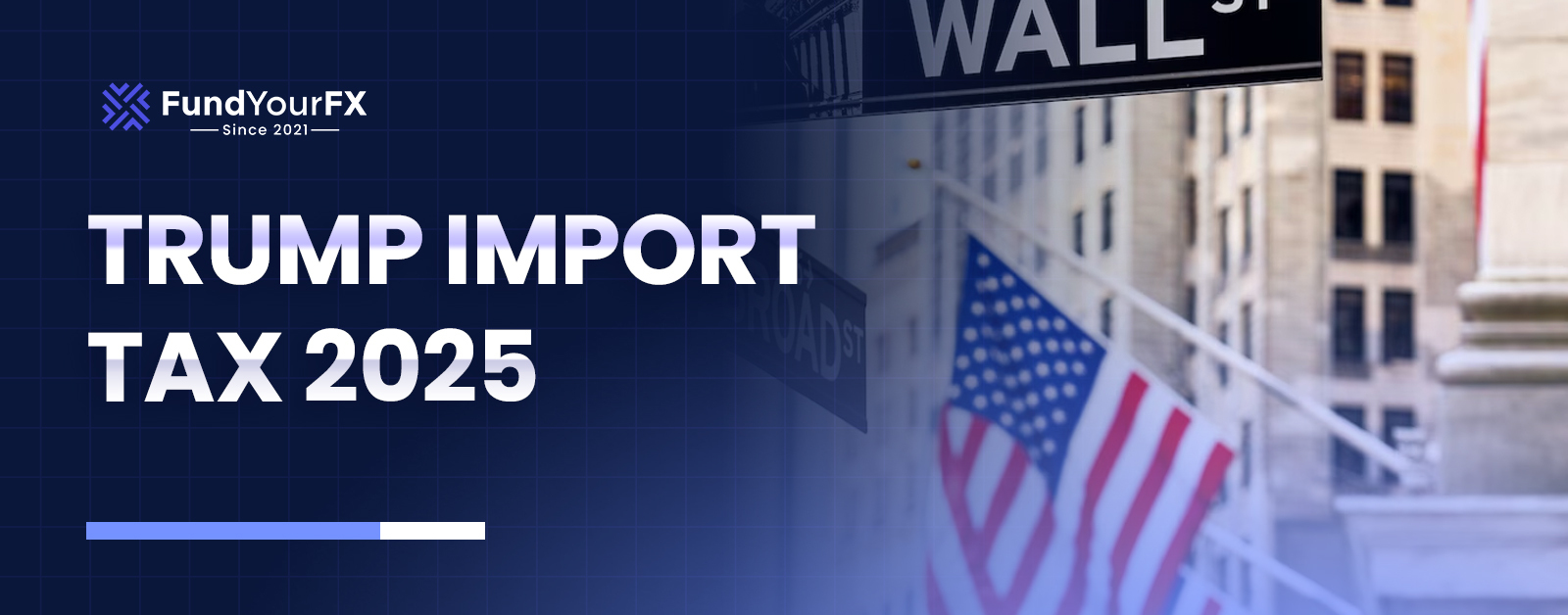As the 2024 U.S. presidential election gains momentum, former President Donald Trump has revived one of his most controversial economic tools — import taxes. His proposed Trump import tax 2025 aims to impose sweeping tariffs on foreign goods, with a particular focus on Chinese imports and other key trade partners. The plan is positioned as a bold move to protect American industries and bring manufacturing back home, but it’s already raising concerns among economists, global leaders, and market participants.
If implemented, Trump’s import tax could have far-reaching effects on consumer prices, global trade relations, and the strength of the U.S. dollar. Businesses that rely on global supply chains might face rising costs, while consumers could see price hikes on everyday goods. For forex traders and investors, this policy could trigger major market volatility and influence the value of USD across key currency pairs. Whether you’re a trader, economist, or everyday consumer, understanding the Trump import tax 2025 is essential as the global economy braces for possible change. For forex traders, the Trump import tax 2025 introduces a layer of policy-driven volatility that must be factored into trading strategies.
What Is Trump’s 2025 Trade Proposal?

Donald Trump has proposed a sweeping 2025 import tax targeting foreign goods, especially from China. The plan could include a universal baseline tariff of 10% on all imports, with higher rates on strategic sectors like technology, steel, and automotive parts. His campaign argues this move would incentivize American companies to bring manufacturing back to the U.S., boost domestic jobs, and reduce trade deficits.
The proposal mirrors his previous 2018–2020 tariff strategy, which sparked a U.S.–China trade war. However, this time Trump suggests a “more aggressive and permanent” tariff system that doesn’t rely on trade negotiations but acts as a standing economic policy.
Critics warn it could backfire, raising prices for American consumers and straining international alliances. Still, to his supporters, it’s a clear signal of economic nationalism and a bold move to reset global trade.
Which countries are affected?
Trump’s 2025 tariff plan introduces sweeping changes to U.S. trade, with a 10% universal tariff and much higher rates for select countries. Here’s a breakdown of the most affected countries and product categories:
🇨🇳 1. China – 34%
China faces one of the steepest hikes. This affects:
- Electronics (smartphones, laptops, components)
- Consumer goods (furniture, toys, appliances)
- Textiles and machinery
🇻🇳 2. Vietnam – 46%
Vietnam, a major exporter to the U.S., will be hit hard, especially in:
- Apparel and footwear
- Electronics assembly
- Furniture and plastic products
🇪🇺 3. European Union – 20%
Targeted products from EU countries include:
- Automobiles and auto parts
- Luxury goods (watches, fashion)
- Industrial machinery
🇯🇵 🇰🇷 4. Japan (24%) & South Korea (25%)
These countries face mid-tier tariffs that will affect:
- Automotive exports
- High-tech electronics
- Consumer appliances
🇮🇳 🇰🇭 🇹🇼 5. India (26%), Cambodia (49%), Taiwan (32%)
These Asian exporters are seeing sharp increases across:
- Textiles and garments
- Footwear
- Semiconductor components (Taiwan in particular)
🚗 6. Auto Industry – 25%
All foreign-made vehicles and parts are subject to a 25% import tax, affecting:
- Japanese and German automakers
- U.S. dealerships relying on imported models
- Repair and parts supply chains
💻 7. Electronics, Machinery & Agriculture
Broader categories impacted across many countries:
- Consumer electronics (smartphones, TVs)
- Heavy machinery and tools
- Imported foods, grains, and packaged goods
Why Should Forex Traders Care?
Trade policies directly impact currency markets. Tariffs can drive inflation, shift interest rate expectations, and trigger geopolitical tensions — all of which move forex markets. Traders should be ready for volatility in key USD pairs.
If Trump’s import tax is implemented, it could lead to higher prices on imported goods, pushing inflation up. This might force the Federal Reserve to adjust its interest rate policy, which would directly affect the value of the U.S. dollar. At the same time, countries targeted by tariffs may retaliate, leading to global uncertainty and sharp moves in currency pairs tied to U.S. trade relationships. Forex traders who stay ahead of these shifts will be better positioned to identify breakout opportunities and protect against risk.
How can traders prepare?
- Monitor Trade Developments and Economic Indicators
Stay informed about tariff implementations, trade negotiations, and economic data releases. These factors can significantly influence currency valuations and market sentiment. Regularly reviewing updates from reliable financial news sources and economic calendars will provide insights into potential market movements
- Utilize Risk Management Tools
Given the increased market volatility, employ risk management strategies such as setting stop-loss orders to limit potential losses. Diversifying your trading portfolio can also help mitigate risks associated with exposure to any single currency pair.
- Focus on Safe-Haven Currencies
During periods of economic uncertainty, investors often turn to safe-haven currencies like the Japanese Yen (JPY) and Swiss Franc (CHF). Monitoring these currencies can offer opportunities, as they may appreciate amid escalating trade tensions.
- Analyze Currency Pairs Affected by Tariffs
Pay close attention to currency pairs involving countries directly impacted by the new tariffs. For instance, USD/CNY and USD/EUR pairs may experience heightened volatility, presenting both opportunities and risks.
- Stay Updated on Central Bank Responses
Central banks may adjust monetary policies in reaction to trade developments. For example, if tariffs lead to increased inflation, central banks might alter interest rates, influencing currency values. Keeping abreast of such policy changes is crucial for informed trading decisions. These shifts could be significantly influenced by the Trump import tax 2025, especially if inflation rises sharply.
Market and political reactions
President Donald Trump’s announcement of sweeping new tariffs has elicited significant reactions from both financial markets and political leaders worldwide. In the immediate aftermath, U.S. stock futures experienced notable declines, with the Dow Jones Industrial Average dropping over 2%, the S&P 500 down 3.7%, and the Nasdaq sliding 4.6%.Investors expressed concerns that these tariffs could escalate into a full-blown trade war, potentially leading to increased inflation and a slowdown in global economic growth. Economists have warned that the effective U.S. tariff rate could reach levels not seen since the early 20th century, raising the risk of stagflation—a combination of rising prices and slowing economic activity.
Politically, the tariffs have drawn criticism both domestically and internationally. In the United States, a Reuters/Ipsos poll revealed that 70% of Americans anticipate that the tariffs will raise prices, and 53% believe they will do more harm than good. Some Republican lawmakers have voiced opposition, concerned about potential negative impacts on the economy and consumer costs. Internationally, key trading partners have expressed dismay and threatened countermeasures. The European Union and China, among others, are considering retaliatory tariffs, raising fears of an escalating trade conflict that could destabilize the global economy.
USD Forecast: Strength or Weakness?
A reduction in imports could initially strengthen the USD, especially if domestic production rises. However, if global retaliation or inflation spikes follow, the dollar might weaken due to market uncertainty or slower growth.
Historically, protectionist policies tend to create short-term support for the dollar due to expectations of stronger internal demand and reduced trade deficits. But if the tariffs lead to higher consumer prices and supply chain disruptions, the Fed may face pressure to balance inflation control with economic stability. In this scenario, the dollar could face mid- to long-term headwinds, especially if investor confidence declines or if global counterparts shift away from USD-denominated assets. For forex traders, this means tracking both macroeconomic indicators and central bank sentiment will be crucial in forecasting USD movement.
Impact on Major Currency Pairs

USD/CNY: High potential for volatility with renewed U.S.–China tensions That’s why understanding the mechanics and reach of the Trump import tax 2025 is essential for any serious trader or investor.
- EUR/USD: May see euro strength if EU avoids direct tariff targeting
- USD/JPY: Safe-haven flows could boost the yen
- USD/CAD: Canada’s deep trade ties mean ripple effects are likely
Conclusion
The Trump import tax 2025 proposal is more than just a political talking point — it’s a potential turning point for global trade, the U.S. economy, and financial markets. From rising consumer prices and strained international relations to increased volatility in the forex and equity markets, the implications are wide-reaching. Traders, businesses, and everyday consumers alike should keep a close eye on how this policy evolves leading into and beyond the 2024 election.
Whether or not these tariffs become reality, the mere discussion of them is already shaping market sentiment. For investors and traders, staying informed, adapting quickly, and managing risk effectively will be key. As history has shown, protectionist policies can create both disruption and opportunity — and those who are prepared stand to benefit the most.







